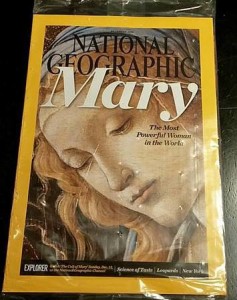 When I was a boy in the South Bronx parish of St. Pius, taught by Dominican nuns, my favorite prayer was, “the Hail Mary.”
When I was a boy in the South Bronx parish of St. Pius, taught by Dominican nuns, my favorite prayer was, “the Hail Mary.”
I was often chosen to lead the Rosary, and I suspect it was because I recited the prayer rapidly.
To this day, I’ll say the Hail Mary, in times of stress and distress, out of those early devotions, as I did repeatedly, while my Mom was undergoing a life or death operation, for a bypass, a prayerful meditation asking that she survive, or die without much pain. She lived another ten years.
But I can’t say my Mother’s recovery from her almost immovable stone hard heart muscle was because I prayed. Nor did my Mom think that was the reason. But she did say afterwards she would never eat pork again, a respectful offering, out of respect for the pig valve that made her heart healthy again and for years afterwards.
In recent days, National Geographic chose as its cover story, Mary, and described her as “the most powerful woman in the world.”
In the past, Geographic has discussed religion and culture as an influence on nation states and tribes.
But has not given such a misleading title to a subject as this issue — for the article is in truth and fact about the cult of Mary and not about the Mary of the Church or of scripture.
So what happened?
After 127 years under the ownership of the not-for-profit National Geographic Society, the magazine and the Society’s assets have been taken over by Rupert Murdoch’s 21st Century Fox.
Murdoch’s purple prose publishing is already evident in this current cover, ascribing to a religious icon the appellation that she is the “most powerful.”
The Aryan image of this strawberry blonde Mary looking more like Cate Blanchett, rather than the more likely image of an historic Mary, perhaps olive skinned and dark haired, is unworthy of Geographic’s past amazing journalism, printed and photographic.
This is, I suppose, how Mary would have looked if Murdoch had made her, rather than Murdoch’s alter ego, God (or Yahweh).
The article is not based on the extent of Mary’s presence in devote rosary readings in churches across the world, an accessible link to the supernatural, or in hospital hallways, waiting on a doctor’s report, but on the miracles of Mary, and we are not talking about the doctrine of her virgin birth, but on her appearance in diverse venues, in the last 450 years, of her 2,000 reported sightings, gifting healthy recoveries to the sick. The most devout bishops have, however, felt it necessary to confirm only 28 of these “apparitions,” and to most of us, that number is accounted for by reverential astigmatism.
Those of us steeped in the Baltimore Catechism know there is no Roman Catholic instruction to believe in such apparitions.
But don’t tell that to the mestizo faithful in Quadalupe, even now preparing for Mary’s feast day at the Basilica on December 12th.
As legend tells it, in 1531, Mary spoke to Juan Diego, in his native dialect, Nahuatl (Aztec language), and instructed him that she wanted a church built where formerly the local worshipped Aztec earth goddesses, and, as the legend goes, Mary granted Juan an iconic image of herself woven in agave fibers – to prove this was no contrivance.
We don’t have enough trouble in the world, in the war of religions, without celebrating illusory religious reveries by cults. Incidentally, the words, “the cult of Mary,” announce to readers this Geographic episode, to air on December 13th.
This cultish devotion of Mary may be Murdock’s counterpoint to Simon Worrall’s earlier Geographic article, before Murdoch took over Geographic, endorsing the view that we have science and religion “as competitors in the field of esoteric truths….” Murdock disserves religion by underscoring its effect as “harmful superstition.” Worral said that one of the meanings of superstition “is a belief that is unfounded or irrational,” like these “apparitions,” and the so-called cures.
My Mom lived, not because of my prayers, but because of medical science. This does not diminish the force of either. But Murdoch’s impulse to spread ignorance compromises both.
